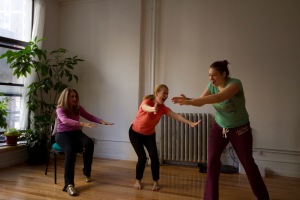After my mastectomy, I was bowled over by the extent of the surgery. I worried about restoring my range of motion and strength. That was bad enough. And then I heard about lymphedema—a permanent swelling of the arm, hand, fingers or chest after breast cancer treatment. In other words, potential for lifetime of discomfort and diminished use of my arm.
I was lucky to have been physically active before my diagnosis, and was eager to get back to that. Imagine my relief to learn that exercise—at the proper time after healing—was not only possible, but good for me. I never did get lymphedema, and decades after my treatment I have full use of my arm, although it does get a bit tired and achy if I overdo something, like kayaking for hours on end.
Recently, the National Institute for Health and Care Excellence (NICE) issued new guidelines. The guidelines say exercise will not make the lymphedema worse and could improve well-being. Their experts say that women who suffer swelling following breast cancer treatment should be encouraged to exercise.
I’d never heard of the National Institute for Health and Care Excellence (NICE) before they issued their important new guidelines. NICE is a non-departmental public body of the Department of Health in the United Kingdom that
publishes guidelines in four areas: The use of health technologies, clinical practice, guidance for public sector workers on health promotion, and guidance for social care services and users. NICE has a high reputation internationally as a role model for the development of clinical guidelines, especially regarding cost–benefit boundaries. So, it behooves us to listen.
The new NICE guidance, recommends that doctors and nurses discuss with patients how exercise may improve their quality of life—especially the one in five people treated for breast cancer who will go on to develop lymphedema.
Although they say that the current evidence shows “exercise does not prevent, cause or worsen lymphoedema”.
Lymphedema can happen when your body’s lymphatic system becomes damaged –in the case of breast cancer, by surgery or radiation–and is unable to drain fluid in the normal way.
Many people are confused and may be leery of exercise, thinking it could cause or worsen lymphedema.
Jackie Harris, clinical nurse specialist at Breast Cancer Care, said “Lymphoedema can be controlled but will never go away and we know that regular exercise has many benefits for those living with or at risk of lymphedema.”
“Regular movement in everyday life or work can help keep joints supple and aids lymph drainage and extra exercises can also be useful if swelling restricts movement of the arm.”
Moving for Life Dance classes are specifically designed to encourage lymph drainage.
Martha Eddy has studied and taught about the movement flow of lymph and how our own movementnchoices can help in increasing the flow, even after the adversity of surgery, radiation or chemotherapy. She has created the Lymphatic Warrior Phrase that can be done seated or standing. Women who have practiced MFL report reduced swelling, less pain, and the ability to fly without swelling worsening when they do the exercises at home or while traveling. 


